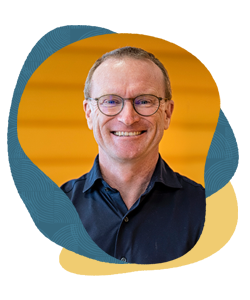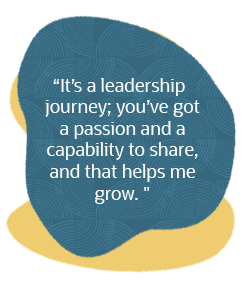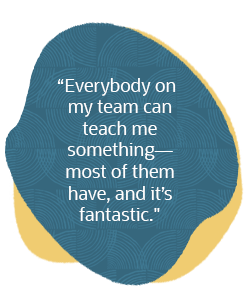Taking the lead: Three years at Oracle
For many, leadership is the top of the career ladder. Taking on responsibility for a team can feel like a natural progression after years of building the experience required to lead. However, reaching the strategic level isn’t the end of a career journey—it’s a whole new start full of exciting challenges.
In Taking the lead, we catch up with executive leaders celebrating Oracle anniversaries and ask them to share their experiences and the lessons learned along the way.
Alistair Green joined us in 2020 as senior vice president of cloud engineering, determined to build up his decades-long technology career with challenge, autonomy, and impact. Three years later, the Japan and Asia Pacific (JAPAC) leader has more than fulfilled his mission.
To celebrate his Oracle anniversary, he sat down for a Q&A with the recruiter who brought him on board. Alistair is interviewed by Mia Ishikawa, executive leadership recruiter for Oracle’s JAPAC region. Based in Tokyo, Mia has a proven track record of finding top C-level talent in the tech market—including some of our strongest leaders.
Tell us about what you do
As the SVP responsible for cloud engineering, I help customers, partners, and developers unlock the power of Oracle Cloud Infrastructure (OCI) to solve their business problems. I have about 400 people in my reporting line. In addition to that, I like to take a leadership role across APAC, including Japan, China, Hong Kong, and Taiwan. When we get everybody together, it’s not just a considerable team—it’s also a considerable capability that we offer to our customers.
Why did you decide to take a leadership position at Oracle?
I was in a good place before I joined, but I was looking for a change. Oracle offered an exciting opportunity to build something new and help it grow in a very similar role. I already knew Oracle apps really well, but I also looked broadly at the people, the innovative strategy, and the technological capability. It’s a unique offering, so that’s why I came on board.
How would you describe your leadership style?
I joined the Royal Australian Air Force as an 18-year-old boy, and I’d be lying if I said it didn’t influence me. I look back very fondly at those times and the leadership experiences I had. Some of those are very different than what I do here, but it taught me about people. The military is an easy commanding and controlling bar, which is good and needed at times, but it also constrains what people think and do. If you are the kind of leader who thinks you know everything and have all the capability in the world, you can just tell people to do things. I don’t think I’m like that and don’t see many people like that in corporate life, so I’ve changed my leadership style over time.
When I took on this role, I coined a hashtag: #peoplealways. We’ve got great technology, but it’s the people that unlock that capability for our customers. As a leader, I need to be mindful of people’s journeys, capabilities, and desires and bring that together with work. They are here to fulfill something in their lives as well, so how can I help them successfully align that purpose with the company and the customers?
I like to collaborate as broadly as possible and learn. Everybody on my team can teach me something—most of them have, and it’s fantastic. I give people the opportunity to try new things and grow, but I don’t constrain or micromanage. I want them to have the authority to work within their role. And when challenges happen, I’d like to hear about it and work through that together.
Have the past three years changed you as a leader?
I’m still passionate about my people and what we are doing. I’m still passionate about our customers. When I first joined, we were on a hypergrowth period, like most tech companies. Technology was critical during COVID-19. We focused a lot on diversity and growth, starting with a transformation program we put on with our people called xCEed. Many of those programs are still going.
 As technology has changed, we’ve launched generative AI. I do a lot of work in sovereign space. It is constant learning, which I love. I even spend more time today with our customers than I did initially. The economic and geopolitical situation has shifted dramatically in the last three years, but that doesn’t change my view. It’s a leadership journey; you’ve got a passion and a capability to share, and that helps me grow.
As technology has changed, we’ve launched generative AI. I do a lot of work in sovereign space. It is constant learning, which I love. I even spend more time today with our customers than I did initially. The economic and geopolitical situation has shifted dramatically in the last three years, but that doesn’t change my view. It’s a leadership journey; you’ve got a passion and a capability to share, and that helps me grow.
How have you and your team helped customers unlock the power of Oracle Cloud?
The reason we are here is to help the customers explore, learn, and adopt OCI. We’ve done all three of those. When I joined, Oracle’s best-kept secret was our cloud. Now, we have a presence in the market. Analysts are saying we’re a hyperscaler, and we still have a long journey ahead of us to grow. We’re aiming for really strong growth to take market share.
Once customers pick up OCI, the key is to help them learn more about what they can do with it. We do this by starting conversations. For example, I met with a couple of customers in Victoria. We talked about generative AI and data stories and what we do with SailGP. My role is to extend their thinking and growth and assure them that an executive at Oracle will support them.
One weekend, we were going live with our customer, Max Life Insurance in India, and we had a network outage with our Mumbai region. I was on calls with the Max Life executive team and our team for the next week to let them know that we’re here, we understand, and this is what we’re doing to fix it. Dozens of people were working behind it, but I had to make that executive commitment to the customer.
How has the technology landscape in APAC changed since you started working for Oracle?
You can’t really say across the region because each country is different. If we look at India, there’s a big focus on the banking sector. We’re doing a lot of open-source work and hopefully doing more with AI, as that’s the growth engine slotted to startups there. In Australia, we’ve started to crack into the public sector. The team down there is working incredibly hard, and we’ve got some great customers like NRMA, Prophecy, and many others. We launched a Singapore region in 2021, and it’s grown incredibly. We’re launching a second one next year. We’ve got customers in all sorts of industries, from government to commercial. The core to this is the cloud engineering team’s commitment to success.
The one thing that every country is concerned about is cybersecurity. Phishing attacks, denials of service, and data breaches have become more prominent in the last year. These will only increase as our geopolitical and economic situation changes. This is where our cloud is actually streets ahead of everybody else; we provide a more secure environment from the start.
What do you look for when you hire new team members?
Attitude and mindset. Most people I talk to have the background and the technical capability. I’m looking for how they approach the job, how they approach the customers, and how they approach people. Have they got the growth mindset? Are they prepared to take risks? Do they understand the implications of taking those risks? Are they going to work within our team? I don’t want a conformist team, but I do want people to work together. It’s good to have that competitive challenge between team members. You know the old saying—iron sharpens iron. Two strong people will sharpen each other and get a better outcome for the customer.
What does the future look like for you at Oracle?
We’re making a lot of headway across the business, and there’ll be some exciting wins coming up in the near future. It’s not just cloud—it’s apps, it’s license, it’s systems, and it’s across the board. There’s a lot of work we still have to do and a lot of paths where we want to go, which is encouraging for the whole business. It’s a lot more fun to be in a growth business with a growth mindset than it is with one that is stagnant. And we’re certainly not stagnating.
Alistair’s work anniversary isn’t just a celebration of the last three years; it’s also a reminder of how much he’s evolved throughout his career. The road to leadership can be long and tedious, but there’s always been one thing that has kept him moving forward: the pursuit of new opportunities. He’s built a successful career by following paths that inspire him to learn, grow, and make an impact—and he’s excited to continue the momentum for many years to come.
Are you ready to fulfill your purpose with a global leader? Explore our career opportunities and start making an impact today.
